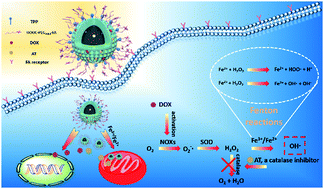Enhanced highly toxic reactive oxygen species levels from iron oxide core–shell mesoporous silica nanocarrier-mediated Fenton reactions for cancer therapy†
Abstract
In this study, iron oxide core–shell mesoporous silica nanoparticles (Fe3O4@MSN) were prepared via the hydrolysis of tetraethyl orthosilicate on the surfaces of Fe3O4 nanoparticles, and these were further conjugated with folate (PEG-FA) and mitochondrial targeting triphenylphosphonium (TPP) to form Fe3O4@MSN-TPP/PEG-FA. A reactive oxygen species (ROS) promoting synergistic combined chemotherapy platform was designed through Fe3O4@MSN-TPP/PEG-FA encapsulating doxorubicin (DOX) and 3-amino-1,2,4-triazole (AT) for cancer therapy. DOX could stimulate the activation of nicotinamide adenine dinucleotide phosphate oxidases (NOXs), which change oxygen into superoxide radicals, which could be further triggered to produce hydrogen peroxide (H2O2) using the superoxide dismutase (SOD) enzyme. AT, as a catalase inhibitor, was employed to inhibit catalase activity to protect the production of H2O2. Thereafter, H2O2 was catalyzed with the help of Fe2+/Fe3+ to form highly toxic free hydroxyl radicals through Fenton reactions, which could induce cell death via synergistic DOX therapy. From in vitro assays, the prepared DOX/AT-loaded Fe3O4@MSN-TPP/PEG-FA showed remarkable inhibition efficiency (3.23% cell viability and 88.1% cell apoptosis) towards MGC-803 cells. This work has created a novel approach to gradually promote the production of ROS and combine this with chemotherapy to enhance anticancer efficacy.



 Please wait while we load your content...
Please wait while we load your content...